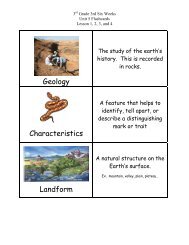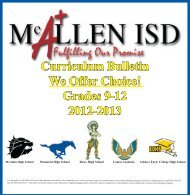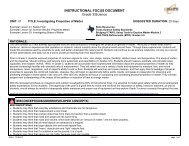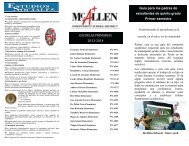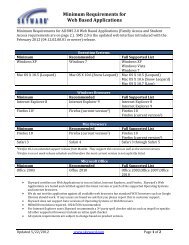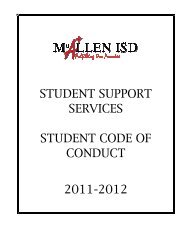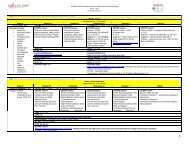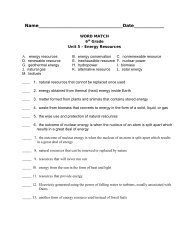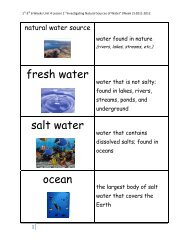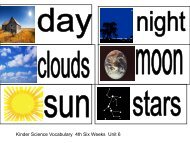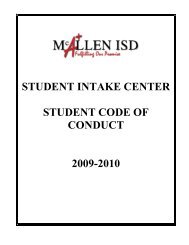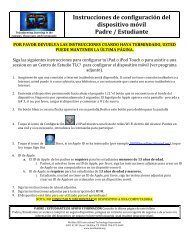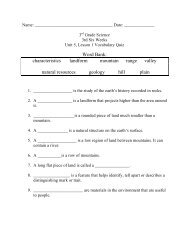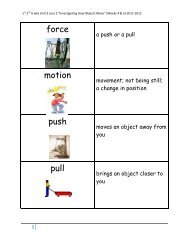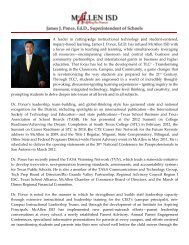Parent Guide for Kindergarten Students for First ... - McAllen ISD
Parent Guide for Kindergarten Students for First ... - McAllen ISD
Parent Guide for Kindergarten Students for First ... - McAllen ISD
You also want an ePaper? Increase the reach of your titles
YUMPU automatically turns print PDFs into web optimized ePapers that Google loves.
1 st Six Weeks<br />
Classroom Routines<br />
<br />
<br />
<br />
Social Studies<br />
Classroom rules and routines ensure safety, order, and<br />
fairness.<br />
Leaders make and en<strong>for</strong>ce rules necessary to ensure safety,<br />
order, and fairness.<br />
Events occur in order and their relationships to each other<br />
can be described in terms of time.<br />
People and Places in the School and Community<br />
<br />
<br />
<br />
Certain terms describe the location of places and objects.<br />
Maps help people define and find where places are located.<br />
People’s jobs contribute to the community.<br />
Celebrate Freedom Week<br />
<br />
<br />
The Constitution, the rules of our nation, helps ensure<br />
freedom <strong>for</strong> all.<br />
Symbols reflect our beliefs and help define us as a country.<br />
People celebrate what is important to them.<br />
2 nd Six Weeks<br />
Classroom as Community<br />
<br />
Leaders make and en<strong>for</strong>ce rules necessary to ensure safety<br />
and fairness.<br />
<br />
Groups can make fair decisions by voting.<br />
Technology can help people accomplish tasks.<br />
Family as Community<br />
Family communities are similar and different.<br />
People need food, clothing, and shelter to survive.<br />
<br />
People’s jobs contribute to the classroom community.<br />
Families are similar and different in the rules they follow at<br />
home.<br />
Customs and traditions help define who we are.<br />
3 rd Six Weeks:<br />
Other Communities – Neighborhood<br />
<br />
<br />
<br />
<br />
Physical characteristics of place shape our communities.<br />
Leaders make and en<strong>for</strong>ce rules and laws to establish order<br />
and provide <strong>for</strong> the security and safety of<br />
the people in the community.<br />
Families in communities are similar and different in their<br />
kinship (relationships), rules, and religions.<br />
People in the community may share similarities or have<br />
differences in the music, clothing and food they like.<br />
Community Celebrations, Customs and Traditions<br />
<br />
<br />
Celebrations, customs, and traditions define us as a country<br />
Celebrations, customs, and traditions define us as a<br />
community.<br />
2012-2013<br />
ELEMENTARY CAMPUSES<br />
Francisca Alvarez Elementary 971-4471<br />
James Bonham Elementary 971-4440<br />
Dr. Carlos Castañeda Elementary 632-8882<br />
Jose De Escandon Elementary 971-4511<br />
Victor Fields Elementary 971-4344<br />
Reynaldo G. Garza Elementary 971-4554<br />
Leonelo H. Gonzalez Elementary 971-4577<br />
Lucile McKee Hendricks Elementary 971-1145<br />
Sam Houston Elementary 971-4484<br />
Andrew Jackson Elementary 971-4277<br />
Christa McAuliffe Elementary 971-4400<br />
Ben Milam Elementary 971-4333<br />
Jose Antonio Navarro Elementary 971-4455<br />
Dr. Pablo Perez Elementary 971-1125<br />
Sam Rayburn Elementary 971-4363<br />
Theodore Roosevelt Elementary 971-4424<br />
Blanca E. Sanchez Elementary 971-1100<br />
Juan Seguin Elementary 971-4565<br />
Thigpen/Zavala Elementary 971-4377<br />
Woodrow Wilson Elementary 971-4525<br />
<strong>Parent</strong> <strong>Guide</strong> <strong>for</strong> <strong>Kindergarten</strong><br />
<strong>Students</strong> <strong>for</strong> <strong>First</strong> Semester<br />
Trans<strong>for</strong>ming Learning in the Campus,<br />
Classroom, and Community<br />
<strong>Parent</strong>s, this is a guide of the required<br />
content <strong>for</strong> <strong>Kindergarten</strong> Grade students’<br />
Texas Essential Knowledge and Skills in<br />
the Core Areas (English Language Arts/<br />
Math/Science/Social Studies).<br />
We encourage you to use this guide as a<br />
means of supporting your child’s<br />
classroom work through the first<br />
semester. If at any time you have a<br />
question about your child's progress,<br />
please contact their teacher to schedule<br />
a conference. Together, this will help<br />
your child master these concepts and<br />
establish a solid academic foundation.<br />
<strong>McAllen</strong> Schools - Since 1908
Mathematics<br />
1st Six Weeks:<br />
Use one-to-one correspondence and language with whole numbers<br />
up to 5 using concrete objects.<br />
Use sets of concrete objects to represent quantities given in verbal or<br />
written <strong>for</strong>m through 5.<br />
Use numbers to describe how many objects are in a set through 5<br />
using verbal and symbolic descriptions.<br />
Model and create addition and subtraction problems in real situations<br />
with concrete objects.<br />
Count by ones up to 30.<br />
Read a calendar using days, weeks, and months.<br />
2nd Six Weeks:<br />
Use one-to-one correspondence and language with whole numbers<br />
up to 10 using concrete objects.<br />
Use sets of concrete objects to represent quantities given in verbal or<br />
written <strong>for</strong>m through 10.<br />
Use numbers to describe how many objects are in a set through 10<br />
using verbal and symbolic descriptions.<br />
Count by ones up to 60.<br />
Use language such as be<strong>for</strong>e or after to describe relative position in a<br />
sequence of objects.<br />
Name the ordinal position in a sequence such as first, second, or<br />
third, etc.<br />
Identify, extend, and create patterns of sounds, physical movement,<br />
and concrete objects.<br />
Use patterns to predict what comes next.<br />
Describe one object in relation to another using in<strong>for</strong>mal language<br />
such as over, under, above, and below.<br />
Place an object in a specified position.<br />
Read a calendar using days, weeks, and months.<br />
Describe and identify an object by its attributes using in<strong>for</strong>mal<br />
language.<br />
Compare two objects based on their attributes.<br />
Sort a variety of objects including two-dimensional geometric<br />
figures according to their attributes and describe how the objects are<br />
sorted.<br />
Describe, identify, and compare circles, triangles, rectangles, and<br />
squares.<br />
3rd Six Weeks:<br />
Use one-to-one correspondence and language with whole numbers<br />
up to 15 using concrete objects.<br />
Use sets of concrete objects to represent quantities given in verbal or<br />
written <strong>for</strong>m through 15.<br />
Use numbers to describe how many objects are in a set through 15<br />
using verbal and symbolic descriptions.<br />
Count by ones up to 80.<br />
Construct graphs using real objects or pictures in order to answer<br />
questions.<br />
Use in<strong>for</strong>mation from a graph of real objects or pictures in order to<br />
answer questions.<br />
Model and create addition and subtraction problems in real situations<br />
with concrete objects.<br />
1st Six Weeks<br />
<br />
<br />
<br />
<br />
<br />
<br />
<br />
The student conducts classroom and outdoor investigations<br />
following appropriate safety procedures that are<br />
environmentally appropriate.<br />
The student develops abilities to ask questions and seek<br />
answers in classroom and outdoor investigations.<br />
The student will identify and explain a problem and use their<br />
critical thinking ability to find a solution,<br />
The student uses age-appropriate tools and models to<br />
investigate the natural world.<br />
Observe and describe weather changes from day to day.<br />
Observe and record properties of objects, including relative size<br />
and mass, such as bigger or smaller and heavier or lighter,<br />
shape, color, and texture.<br />
Observe, record, and discuss how materials can be changed by<br />
heating or cooling.<br />
2nd Six Weeks<br />
<br />
<br />
<br />
<br />
<br />
<br />
The student develops abilities to ask questions and seek<br />
answers in classroom and outdoor investigations.<br />
The student uses age-appropriate tools such as magnets and<br />
notebooks to investigate the natural world.<br />
Use the five senses to explore different <strong>for</strong>ms of energy such as<br />
light, heat, and sound.<br />
Explore interactions between magnets and various materials.<br />
Observe and describe the location of an object in relation to<br />
another such as above, below, behind, in front of, and beside.<br />
Observe and describe the ways that objects can move such as in<br />
a straight line, zigzag, up and down, back and <strong>for</strong>th, round and<br />
round, fast and slow.<br />
3rd Six Weeks<br />
<br />
<br />
<br />
<br />
<br />
<br />
<br />
Science Language Arts & Reading<br />
Develops abilities to ask questions, seek answers in classroom<br />
and outdoor investigations, and communicate observations with<br />
others.<br />
Uses age-appropriate tools such as hand lenses, primary<br />
balances, bowls, notebooks, non-standard measuring items such<br />
as paper clips and clothespins to investigate the natural world.<br />
Weather instruments such as thermometers and wind socks will<br />
be demonstrated.<br />
Observe and record properties of objects, including relative size<br />
and mass, such as bigger or smaller and heavier or lighter,<br />
shape, color, and texture.<br />
Observe, describe, compare, and sort rocks by size, shape,<br />
color, and texture.<br />
Observe and describe physical properties of natural sources of<br />
water, including color and clarity.<br />
Give examples of ways rocks, soil, and water are useful.<br />
Use senses as a tool of observation to predict and identify<br />
properties and patterns such as weather changes and seasons of<br />
the year.<br />
1st Six Weeks<br />
<br />
<br />
<br />
<br />
<br />
<br />
<br />
Understand that printed words are associated with spoken<br />
language.<br />
Develop an awareness of sound patterns of spoken words.<br />
Respond to spoken messages.<br />
Understand that larger words are made up of smaller words.<br />
Understand that letters and letter combinations represent words.<br />
Understand that writers develop ideas about what they know.<br />
Develop ideas about what they know.<br />
2nd Six Weeks<br />
<br />
<br />
<br />
<br />
<br />
<br />
<br />
<br />
Understand that print is associated with spoken language and that<br />
it supports the development of reading and writing.<br />
Understands that literary elements helps reader’s ability to make<br />
meaning of texts.<br />
Respond to spoken messages.<br />
Understand that authors write <strong>for</strong> a purpose<br />
Identify facts in texts to create a better understanding of purpose<br />
and meaning.<br />
Understand that effective conventions enhance the interpretation<br />
of messages.<br />
Understand that writers develop ideas about what they know.<br />
Develop an awareness of word patterns and that it supports the<br />
development of word reading and spelling.<br />
3rd Six Weeks<br />
<br />
<br />
<br />
<br />
<br />
<br />
<br />
Develop an awareness of sound patterns of spoken words and<br />
how it supports the development of word reading and spelling.<br />
Develop an awareness of word patterns and how it supports the<br />
development of word reading and spelling.<br />
Understands that literary elements help reader’s make meaning of<br />
texts.<br />
Use strategies to support understanding of texts.<br />
Create connections to make texts personally relevant and useful.<br />
Use oral conventions to enhance interpretation of messages and<br />
ideas.<br />
Understand that writers use literary techniques to enhance the<br />
reader’s and/or listener's experience.



